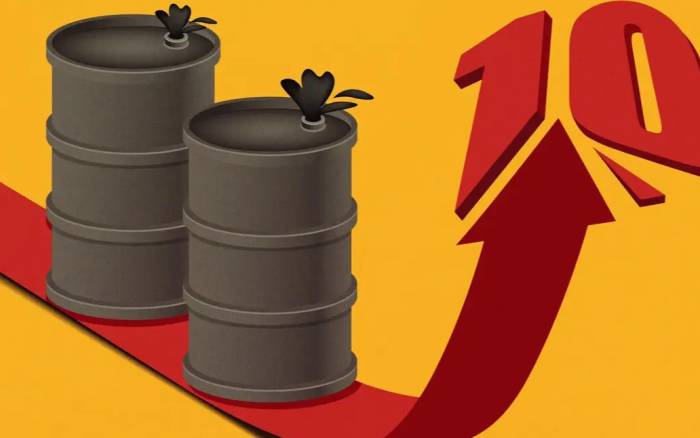The global oil market has seen unprecedented fluctuations, particularly highlighted by a single day drop of over 8% in international crude oil prices. This volatility triggers significant implications on domestic fuel prices, which are intrinsically linked to such international rates. Let’s delve into what fuels these shifts and their economic repercussions.
As the regulations dictate, domestic refined oil prices are adjusted in correspondence with the movement of international crude oil costs. This adjustment is calculated using the weighted average price of crude oil over two adjustment periods. Consequently, for those who keep a close eye on oil prices, it is imperative to monitor these international changes. On July 5, crude oil prices experienced a staggering plunge, with West Texas Intermediate (WTI) futures falling by 8.19%, dipping below the critical $100 mark—a stark contrast compared to two months prior when prices were oscillating around this threshold.
Brent crude oil also followed suit, reflecting a significant decline of 7.67%, stabilizing around $104.80 per barrel. Such substantial changes are likely to affect refined oil prices in the upcoming adjustment cycle. Analyzing the data up to July 5, we find ourselves on the sixth trading day of the current pricing period, which runs until July 12. With this momentum, predictions forecast a notable decrease in refined fuel prices. Current estimates suggest a ripple effect translating to a reduction of approximately 135 Yuan per ton, leading to about a 0.11 Yuan decline per liter in the prices of both 92 and 95 octane gasoline, as well as diesel fuel.
Advertisement
While the definitive drop on July 12 seems almost assured, the exact price adjustments per liter remain a question of speculation. Several factors contribute critically to the recent downturn in oil prices. A primary factor involves an increase in oil supply, orchestrated partially by the U.S. pressuring Saudi Arabia and other oil-producing nations to elevate output. Their compliance, resulting in an agreement to ramp up production over the coming months, has further eased the market’s supply constraints.
Additionally, the actions of the Federal Reserve are having a direct influence on crude oil prices. The Fed’s decision in June to raise interest rates by 75 basis points could foreshadow further hikes in July, with expectations of increases of 50 to 75 basis points looming large. The intersection of monetary policy and the oil market is crucial, as higher interest rates typically draw investment from commodities into dollar-denominated assets, reducing liquidity in commodity markets. A corresponding surplus of sellers over buyers naturally drives prices down.
Market sentiment during inflationary periods is another critical factor at play. The global economy has been tainted by fears of a downturn, where the CPI reached alarming heights—recent reports indicated that the U.S. CPI hit a staggering 8.6% in May, while Eurozone inflation also squared up at 8.6% in June. Many developing nations have seen their CPI figures breach double digits. The anticipation of rising inflation has spurred central banks worldwide to adopt strategies that include tightening monetary policy through interest rate hikes, with the dual aim of curbing inflation and possibly staving off economic stagnation or recession. Naturally, when economic vitality wanes, the demand for oil diminishes, impacting price levels.
Revisiting the economic climate of late 2020, we witnessed the lowest oil prices—recorded as low as $30 per barrel—predicated on a drastic decrease in demand spurred by the COVID-19 pandemic. The downtrend was exacerbated by widespread economic disruptions, highlighting a cycle where diminished demand leads to lower prices, creating a feedback loop. Surprisingly, some analysts speculate that if current trends continue, oil prices could potentially nosedive to levels as low as $65 per barrel, posing dire consequences for domestic fuel costs, which could revert to single-digit figures.

In examining regional variations of gasoline prices across major cities such as Shanghai and Chongqing, disparities are evident. For instance, in Shanghai, the price for 92-octane gasoline hovers around 9.03 Yuan per liter, while Chongqing sees a higher price point at 9.12 Yuan per liter for the same grade. Unique market dynamics also affect regions such as Hainan, where gasoline prices soar above 10 Yuan per liter, predominantly due to local factors such as free highways.
Looking ahead to July 12, the trajectory suggests a notable decrease in domestic refined oil prices, potentially allowing 92-octane gasoline to dip back below the 8 Yuan per liter threshold, while 95-octane may fall beneath 9.5 Yuan. This upcoming adjustment promises relief for many consumers, particularly for drivers facing steep travel costs due to prolonged high fuel prices. In conclusion, as the international market continues to oscillate, the hope rests on sustaining this downward trend to provide financial alleviation for those grappling with the economic impacts of these shifts.
- 2024-10-08
Leave Your Comment